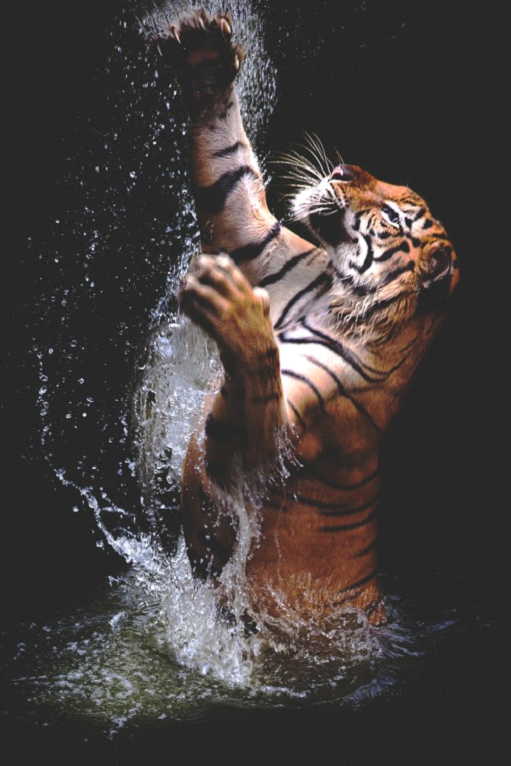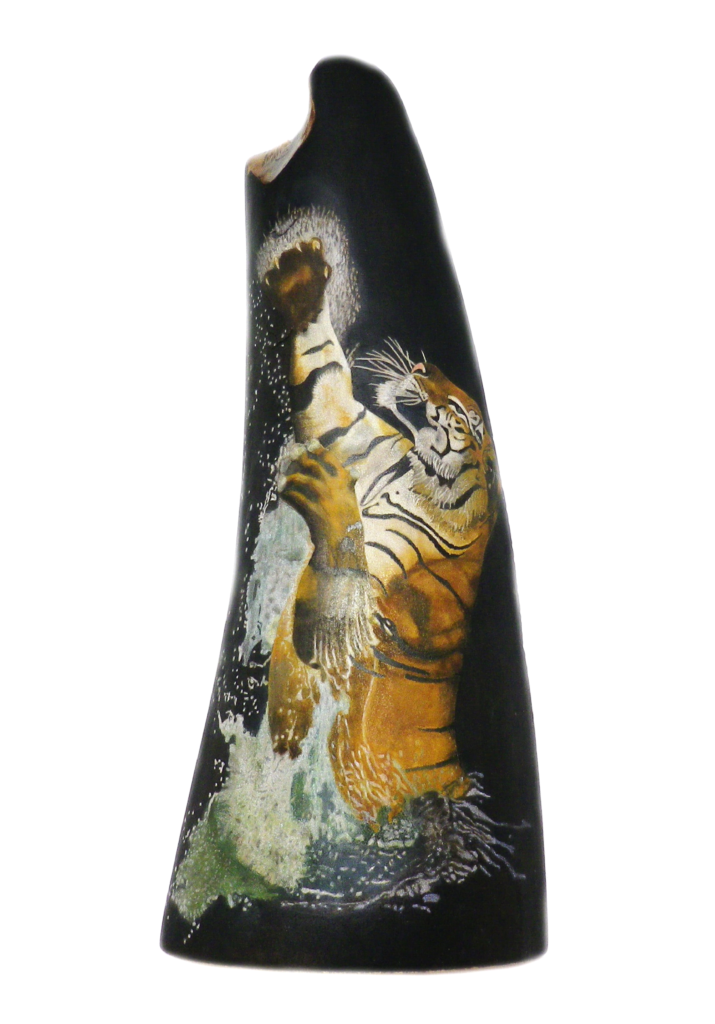
Rod Lacey is a scrimshaw artist from Australia who enjoys a challenge. When I first saw the piece I thought he’d branched out to buffalo horn until I glanced at the tip, then I was even more intrigued. Stippling a piece this large would have taken months by hand, and scribing almost as long. He was kind enough to break down his steps as you’ll see below, along with his description of his work.

Rod chose a dramatic picture of a tiger leaping in the water. The subject and the movement would be a challenge just on a flat piece of paper, let alone a curved surface. “This picture shows the next scrimshaw I will attempt; the ivory is quite stained with a brown color because of being buried in the ground for thousands of years, this discoloration will mainly affect the white areas as the white paint doesn’t cover easily.”

“The Mammoth Ivory weighs 805grams (1 pound and 12.396 ounces) and measures 26cm x 14cm (10.24″ x 5.5″) wide around the curve at the base. The black background will take many many hours of stippling, that’s scrimshaw, you don’t do scrimshaw if you’re in a hurry. Stage 1- 27/3/2020
This picture shows the raw ivory; let’s see what it will become.”

(“The Whaleman’s Way” is an age-old technique of getting the map of the image you want onto the ivory. Stippling through the paper into the ivory below, you can then fill in the stipples with ink and see the outline of the image.)
“Stage 2- 27/3/2020
This picture shows the ivory with the tiger picture attached ready to cut the outline”
Image on paper, attached to the ivory.

(I was curious as to the technique Rod used to fill in the black. Using a scribe, Rod first stippled lines top to bottom, then he went side to side, extremely closely. A bit over one month of precise stippling, at about 30 hours). “Stage 3- 5/4/2020 This picture shows the black areas filled in, next I will do the water, dang this will take some time, the solid black took enough time, but it will seem like a breeze compared to the water.”

Stage 4- 29/4/2020
This picture shows the water finished, this was very time expensive, but that’s scrimshaw. Next is the Tiger; this should be the easiest section.

Stage 5- 5/5/2020 Finished at last, contamination of the colours was a real issue with this one. (Contamination can be extremely frustrating, Each color is added individually, and whether you use ink or oil paint, it easily wicks into adjacent areas despite another color already in the scribed areas. One solution can be to mask the areas, though when you’re working in such small areas it could drive you mad. Another way is to coat the piece each time with archival ink, but this can work against you making the areas you scribe next reject the ink since the wax can seep into the ivory. This may make you need to incise deeper, causing the lines to appear rougher. One possible solution would be to use bees wax instead of archival wax which has solvents in it, then a hand polishing with a soft cloth to leave the bees wax in the incisions, but not allow it to seep into the ivory. I haven’t tried this yet, but I may soon do an a/b test to verify my hypothesis).
To see more of Rod’s work, head over to https://scrimshawaddiction.com for a great education and some stunning work, both in scrimshaw and woodworking.